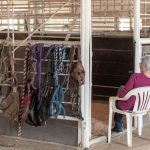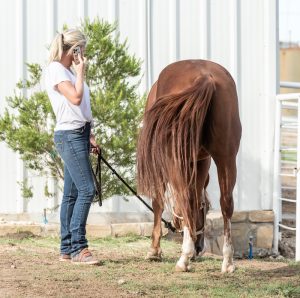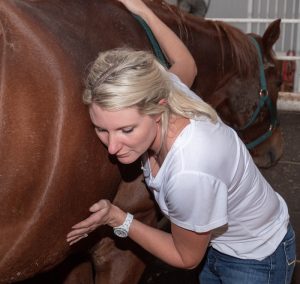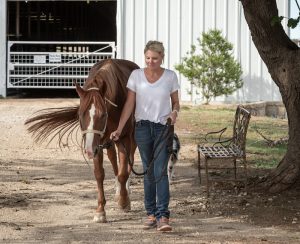 On those days when I wake up to a cool and humid morning, after a day filled with warm sun I immediately begin to worry.
On those days when I wake up to a cool and humid morning, after a day filled with warm sun I immediately begin to worry.
Why is this?
In my professional experience, radical changes in weather, more specifically barometric pressure is the perfect recipe for the dreaded “C” word—colic!
With three barns full of horses of all ages, stages, and health particulars, over the years I have noticed a consistent pattern in colic cases. A large majority are linked to this barometric swing.
Horses are far less prone to colic when it gets hot and stays hot—or when it gets cold and stays cold. No problem. Weather that changes over a period of two or three days is not the problem. It’s those wild shifts that we have here in Texas (one day you’re out there sweating, wishing you’d worn shorts to the barn, and then next day you’re pawing round your closet trying to find your coveralls) that affect barometric pressure enough to cause trouble in a horse’s digestive tract.
So, what can we do to catch a colic early?

Well for one thing, remember to keep an eye on the barometric pressure during weather changes (Most weather apps list this in the section with the wind,temperature, and humidity, and a change of more than .18 in less than three hours is considered significant.), and make sure to pay extra attention to anything that may seem a little off about your horse during these times. At 4Hearts Ranch, our team is trained to keep an eye on all our horses for specific early colic “tells,” including horses who aren’t eating with their usual gusto or when there is less manure than usual in a horse’s stall when they go in to clean. Our barn crew knows the habits of each horse so well that they are our first line of awareness that something is out of the ordinary for one of our horses. In addition to training—and reminding—my crew to stay especially vigilant during sudden weather changes, I also walk all three barns every day—and more often than that during big weather shifts—just to do my own visual checks. It takes a village to keep a close eye on 100 horses, so we encourage everyone in our community to make a habit of checking on the horses in their immediate vicinity to help watch out for signs of colic during big weather changes.
While every horse is different, and a horse will usually only show a few of these signs during a colic episode, seeing any of these things is a red flag to keep a close eye on that horse. The American Equine Veterinary Association says the things to watch for include:
- lack of or decreased amount of manure in the stall
- loss of interest in eating or drinking
- turning the head toward the flank
- pawing
- kicking or biting at the belly
- stretching out as if to urinate, without doing so
- repeatedly lying down and getting up, or attempting to do so
- repeated rolling, often with grunting sounds
- sitting in a dog-like position, or lying on the back
- holding the head in an unusual position, e.g., with the neck stretched out and the head rotated to one side
- leaving food or being completely disinterested in food
- putting the head down to water without drinking
- lack of bowel movements or fewer bowel movements than normal
- reduced or absent digestive sounds
- inappropriate sweating (e.g., unrelated to hot weather or exercise)
- rapid breathing and/or flared nostrils
- elevated pulse rate (greater than 50 beats per minute)
- lip curling
What do you do if you think your horse is starting to colic?
Also, according to the AEVA (and every single vet I know), here’s some time-tested advice:

Call your vet. Be ready to provide specific signs of colic, and their severity, including
- pulse or heart rate (beats per minute), measured over the heart (just behind or above the left elbow) or over an artery (e.g., at the sides of the fetlock or on the underside of the lower jaw)
- respiratory rate (breaths per minute), measured by watching the rise and fall of the flank with each breath
- rectal temperature
- color of the gums (white, pale pink, dark pink, red, or bluish-purple)
- moistness of the gums (moist, tacky, or dry)
- refill time for gum color (the time it takes for the color to return to the horse’s gum after you briefly press on the gum with your thumb; normal is one to two seconds)
- digestive sounds (if any), easily heard by putting your ear to the horse’s side back near the flank
- bowel movements, including color, consistency, and frequency
- any recent changes in management, feeding or exercise
- medical history, including deworming and any past episodes of colic
If you don’t know how to do things like check respiration, pulse, temp, gums, or listen for gut sounds, give me a shout, and we can practice together! It’s good to know (and practice) these checks before you have to—and practicing will also help you get familiar with what’s normal for each horse!

Stay calm and act quickly
Because you can’t always get hold of a vet right away, and time is of the essence, it’s wise to be prepared for what to do in the meantime, including:
- if your horse is pastured, move him to a smaller enclosure like a stall or small paddock.
- if it’s getting dark, arrange for some lighting
- if he wants to rest, let him stand quietly; if he is trying to roll, keep him walking (as opposed to previous wisdom that said keep them walking no matter what)
- remove all the hay and grain from your horse’s stall but leave some water
- while opinions differ on whether to administer Banamine while waiting for the vet, discuss this with your vet in a non-emergency conversation, and if they agree, keep some Banamine paste on hand in a climate-controlled storage space (either at home or the barn fridge with your name on it!)
- The American Association of Equine Practitioners (AAEP) advises the use of Banamine paste over injectable Banamine for non-veterinary horse owners. (“Even with practice, every intravenous injection carries some risk. If medication is inadvertently administered into the external carotid artery instead of the external jugular vein, it can be fatal to the horse.”)

A quick note here (and this does not substitute for having this conversation with your vet), a favorite vet of mine once said, “Giving Banamine doesn’t hurt, but not giving it can result in a much worse colic and even death.” Her advice was always, “Hallie, if you see signs of colic, give Banamine and then call me—and if the Banamine takes care of it and you don’t need me, then praise the Lord!”
The good news is that most cases of colic are mild and resolve with simple medical treatment (and sometimes with no specific treatment at all!). Less than 10 percent of all colic cases are severe enough to require surgery or cause the death of the horse. Nevertheless, colic is still the number-one killer of horses, and it’s important to take even a slight suspicion of colic seriously because in the early stages it can be difficult to tell a mild colic from a potentially serious one.
Another thing to remember is that colic is a symptom—a terrible bellyache that really hurts—not a disease. While many different conditions can cause a horse to colic, by staying alert and intervening quickly, we can usually help our horse through a colic and back to full recovery.



